|

by Andy Lloyd
April 21, 2005
from
DarkStar1 Website
Sedna is the name given by astronomers for the newest planet to be
discovered orbiting the Sun.
Although the details of the size of the
planet are still being sought, it is thought to be about 1300 miles
in diameter and could be of a similar size to Pluto.
Given the Pluto
is generally accepted to be a planet in its own right, Sedna becomes
the tenth planet to be found orbiting the Sun.
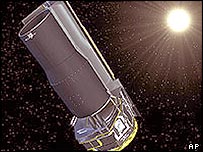
NASA put out information about an
announcement planned for Monday 15th March, to be given by Dr
Michael Brown of Caltech (1). His team had recently discovered
another large Edgeworth-Kuiper Belt object called
2004 DW, details
of which were released in February (2).
His team are using the
recently launched Spitzer Space Telescope. At that time he made the
following comment:
"It's now only a matter of time before something is going to be
discovered out there that will change our entire view of the outer
solar system".
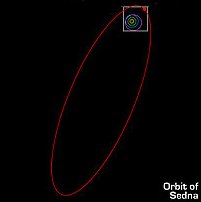
Barely a month later the latest discovery has
been announced, this time of a body that might rival Pluto in size,
and can properly be called a planet:
"Brown, along with Drs. Chad Trujillo of the Gemini Observatory,
Hawaii, and David Rabinowitz of Yale University, New Haven, Conn.,
found the planet-like object, or planetoid, on Nov. 14, 2003."
(4)
It is currently located in the Edgeworth-Kuiper belt some 13 billion
km from the Sun (3), or about 85 Astronomical Units, which is about
three times more distant than Pluto. This places it in the
Kuiper
Gap, or Kuiper Cliff, an area unexpectedly devoid of predicted
objects.
Perhaps it may help to explain the lack of companions out at this
distance, although it is probably too small in practice to have
swept the Belt clean by itself.
However, although it is located here, it may actually be an object
from the distant
Oort Cloud of comets. At the moment it is nearing
perihelion, which has brought it into the Kuiper Belt. It is the
most distant object to have been located orbiting the Sun. It
appears to be following an elliptical orbit of about 10,500 years
duration, taking out to a phenomenal 900 AU when at aphelion (4).
Size-wise, it is too small to be a 'Nibiru' type-entity,
irrespective of whether Nibiru turns out to be a terrestrial planet
or a gas giant. Nor is this rocky, icy world anything approaching a
'Dark Star', even though it is red (presumably die the deposit of
organic material on its surface).
But it is a thrilling discovery,
even so.
Dr David Whitehouse, writing for the BBC, states that,
'astronomers
at the Tenagra Observatory in Arizona were asked to provide
positional information so that an orbit could be determined for
Sedna'.
It has also been imaged by the Hubble Space Telescope
(3).

The Inuit sea-goddess Sedna
The new planet has been named 'Sedna',
after the Canadian and Greenlandic Inuit Sea Goddess (6):
"Sedna, the Sea Spirit, exercises
suzerainty over all animals which
provide food for humans. In her residence at the bottom of the sea,
from where she sends out the animals for hunting, she takes on the
form of a woman. Even shamans fear her." (5)
One can see why the Arctic symbolism has been deployed: a Sea
Goddess at the bottom of the cold Abyss who sends forth her hunters
in the form of the EKBOs.
Quite poetic, really, for astronomers!
(Just kidding, guys).
More Information Emerges
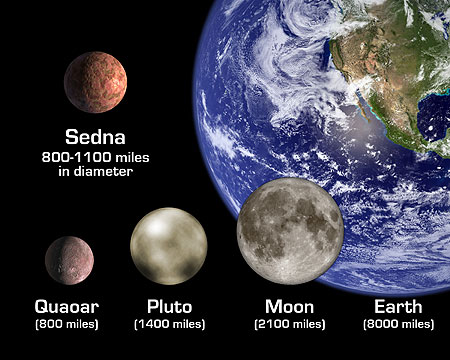
The discovery of this object is not entirely
unexpected, in that new technology is helping astronomers to look
deeper into the void beyond Pluto to search out dark objects, some
of them clearly sizeable.
If Sedna turns out to be as large as Pluto, which is still possible,
then it would properly be called a planet. However, this is likely
to re-ignite debate about what a planet really is, and whether Pluto
itself is simply a large, spheroid-shaped asteroid, accompanied by
its relatively large 'moon' Charon.
At the moment, it is thought to be smaller than Pluto, but bigger
than Quaoar, so it is by no means certain what will be decided for
it in time.
Sedna is currently at its closest approach to the Sun, of
'perihelion'. Its orbit is elliptical, but falls well within the
boundary of the inner Oort Cloud at its most distant point in its
long orbit.
So it behaves somewhat like a planetary comet.
This finding,
according to Dr Brown, might also cause astronomers to rethink the
position of the comet-cloud:
"The elliptical orbit of Sedna is unlike anything previously seen by
astronomers. However, it resembles that of objects predicted to lie
in the hypothetical Oort cloud.
The cloud is thought to explain the
existence of certain comets. It is believed to surround the Sun and
extend outward halfway to the star closest to the Sun. But Sedna is
10 times closer than the predicted distance of the Oort cloud. Brown
said this "inner Oort cloud" may have been formed by gravity from a
rogue star near the Sun in the solar system's early days." (4)
Speculation about the existence of a binary star at the early point
in the solar system's history is now bound to grow, as will the
possibility that the Sun was subject to a stellar 'fly-by'.
Of this
I will have more to say in 'Binary Companion', a book I am in the
process of completing. Suffice it to say that the outer solar system
is starting to look like a very interesting place indeed.
So what can we expect next:
-
Planet XI, Planet XII, Planet XIII...?
-
Is there an Earth-sized planet out there that might have something
to do with this gap in the
Edgeworth-Kuiper Belt?
-
Is there something
even larger further out, like a binary 'dark star' that may still be
lurking among the comets?
No one knows for sure, but what is likely
is that discoveries will continue to be made as the ability of
astronomers to discover increasingly dark and distant objects
orbiting the Sun improves.
In the meantime, congratulations to the
Spitzer team at Caltech!
Anomalies Fuel Scientific Speculation
There are several anomalous aspects to this discovery, not least of
which is Sedna's orbit.
It is simply not behaving as it should, at
least according to the model of the solar system used by
astronomers. To have such an elliptical orbit it would have to have
been pulled out of an ancient circular orbit by some other, massive
object.
Yet no such object is known to exist out there, and the
potential existence of an undiscovered massive object has long been
dismissed by astronomers.
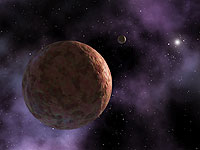
NASA's Sedna painting
However, Sedna's discovery has lead to new
speculation amongst some of the biggest names in planetary science.
The leader of the team who discovered Sedna, Dr Michael Brown, has
questioned whether the previously accepted position of the inner Oort Cloud is correct, and wonders whether the Sun formed in a star
cluster whose brethren may have dragged minor planets like Sedna
into eccentric orbits (7).
Other astronomers, each with their own pet theories about the outer
solar system, have contributed other ideas, like the effect of a
passing star, or interaction with Gigantic Molecular Clouds.
Perhaps surprisingly, the head of the Minor Planet Centre, Brian Marsden, has gone on record speculating about the existence of a
terrestrial-sized planet, or bigger, several hundred
AU away:
"Marsden favors an object closer in, a "planetary object," he told
Space.com , perhaps at between 400 and 1,000 AU.
"Perhaps there's
more than one planet out there," Marsden said. "Who knows? But let's
suppose it is something of an Earth mass, maybe even a few Earth
masses. A close approach could throw this object [Sedna] from
something more circular into something more eccentric."
"Marsden says such a scenario leaves open the question of how an
Earth-sized planet could have formed so far from the Sun, where raw
material should have been sparse, according to current theory. Brown
said an Earth-sized planet is indeed a possibility. But his team's
calculations put it at about 70 AU.
"We think it's unlikely, because
we think we would have found it by now," Brown said in a telephone
interview." (7)
The view put forward by Mike Brown here is similar to
the problem faced by Brunini and Melita when they argued for an
embedded planet in the Edgeworth-Kuiper Belt (8).
Although their
calculations created a reasonable model for the truncation of the Edgeworth-Kuiper Belt, particularly, as it turns out, with a more
eccentric orbit for such a planet (9), the question of its lack of
discovery is an urgent and difficult one.
If it lies further out, it must be more substantial in size to
create the same effect, which is why Dr Marsden opts for a
multiple-Earth-mass planet. But then how did such a body form in
this region of low density of matter?
The problem becomes more complex still.
We also have the question of whether the truncation of the
Edgeworth-Kuiper Disc was caused by a very massive object. Models of
stellar fly-bys can produce some, but not all, of the observed
effects (10).
I am given to understand that a Jupiter-plus sized
object in an eccentric orbit would create the truncated disc,
although my source in the astronomical community who carried out
these revealing calculations doubts whether one could still be out
there. I am not so sure, particularly given Sedna's orbital
properties.
Could a very substantial planet still be out there and have evaded
detection?
I have argued that that is the case on several occasions
(11), and this view seems to have been backed up by Dr Brown's
analysis of previous searches, like
IRAS:
"...Brown said there is one unexplored region of space left,
amounting to about 20 percent of the sky, that hasn't been searched
for an Earth-sized object that would be orbiting at 70 AU and
presumably in the main plane of the solar system.
It is the region
toward the bright galactic centre, which is harder to search. Brown
said his team is considering making that search now." (7)
The densest region of the Milky Way lies in the vicinity of
Sagittarius.
This is a prime hunting ground for
Nibiru for a number
of reasons, not least of which are textual references to it that
constellation being the direction the mythical planet departs
towards (12,13). I have argued that Nibiru currently lies north of
Sagittarius.
There are other, more scientific reasons for
considering this region for a candidate object, which I will discuss
in 'Dark Star'.
Mean Motion Resonance
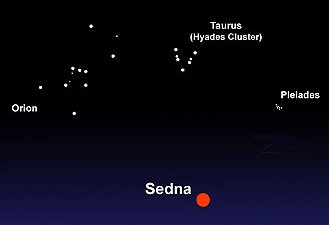
As it turns out, Sedna has been found close to
where I have argued for the sky location of the perihelion transit
of Nibiru (near Sirius and Orion). This is in the opposing part of
the sky from Sagittarius. Sedna is also near to perihelion, moving
from Cetus towards Taurus, which seems to be pro-grade.
Is its orbit
related to a larger body like Nibiru?
Such a situation could readily exist because bodies in the outer
solar system tend to establish orbital correlations between each
other called 'mean motion resonances' (14). Pluto has a commensurate
orbit with Neptune, for instance, in this case a 2:3 mean motion
resonance. Many of the Edgeworth-Kuiper Belt Objects have similar
resonance ratios with Neptune.
So if Nibiru is orbiting the Sun in the outer solar system, and if
it is a substantial planet (and I advocate a sub-brown dwarf, a
spectral class that has yet to be observed but has been modelled
(15)), then it will interact with the other celestial bodies within
the considerable sweep of its eccentric orbit.
Over time, Nibiru would have ejected many so-called
scattered disc
objects (and the Edgeworth-Kuiper Belt is known to be massively
depleted), causing the truncation of the Edgeworth-Kuiper belt, and
those objects that remain in its sphere of influence will have taken
on resonant orbits with it. So it is certainly not beyond reason
that Sedna is in a resonant orbit with the much larger Nibiru.
If
so, its orbital period would take on a single figure ratio in
relation to that of Nibiru's.
When discussing the orbit of Nibiru
Zecharia Sitchin proposed that
it was about 3600 years, synchronous with the fundamental number in
the Sumerian sexagessimal numbering system of 3600, or 1 'Sar' (12).
Sedna's orbital period is about 3 times this number. So Sedna may
have a 3:1 mean motion resonance with Nibiru. If more bodies are
found in similar orbits, which now seems likely, then they too may
be found to have a fundamental mean motion resonance with the
proposed massive body Nibiru.
As Spitzer and other surveys carry on
their work over next year or two, a pattern of newly discovered
bodies may emerge, which will only increase speculation about the
existence of a massive undiscovered body.
LaGrangian Points
Another possibility is that Nibiru has an attendant set of clusters
of comets, asteroids and minor planets.
There are mathematical
locations in a three body system that are stable regions, and these
are called LaGrangian points, after the 18th Century mathematician
Joseph Louis LaGrange.
So, if we took the example of Nibiru and the
Sun as the two main bodies, and thought about minor objects that
could be located at these stable points with respect to Nibiru's
orbit:
"Three of the LaGrangian points lie on a line connecting the two
bodies. The others fall 60 degrees ahead of and behind the smaller
of the two masses... Since the real solar system contains more than
two planets and one asteroid, the LaGrangian points are not points
at all, but regions." (14)
An example of this are
the Trojans, two clusters of asteroids within
Jupiter's orbit that have a mean motion resonance with the gas giant
of 1:1.
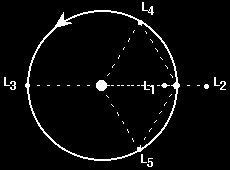
"Lagrange showed that three bodies can lie at the apexes of an
equilateral triangle which rotates in its plane. If one of the
bodies is sufficiently massive compared with the other two, then the
triangular configuration is apparently stable. Bodies at such points
are sometimes referred to as Trojans.
"The leading apex of the triangle is known as the leading Lagrange
point or L4; the trailing apex is the trailing Lagrange point or L5.
Collinear with the two large bodies are the L1, L2 and L3 unstable
equilibrium points which can sometimes be useful places for
spacecraft." (16)
John Bagby, a researcher who, several decades ago, considered the
possibility that the Sun might have up to 20 undiscovered
companions, offered the thought that immense clusters of bodies at
the LaGrangian points might help distribute mass around the orbital
path of the candidate objects he proposed, creating a complex outer
system (17). (He remains convinced to this day that a number of
these bodies, perhaps all (!), await discovery).
One could also imagine cometary showers occurring when these
LaGrangian points are at perihelion.
So perhaps Sedna is part of a
cluster of minor planetary bodies passing through the
Edgeworth-Kuiper belt that is in a 1:1 mean motion resonance with
Nibiru. Again, if that is so then many other bodies contained within
that cluster are about to come to light: Sedna is only 72 years away
from
perihelion.
This might be interesting news to those who believe
that comet activity in the solar system is on the rise.
The implication of this speculation is that Nibiru may have a much
larger orbit than previously thought; possibly three Stars, or about
10,800 years. The Dark Star Nibiru would then currently lie about
1000 AU away. In that case, its last perihelion transit would have
been about 5770 years ago. And this would explain why it has not
been seen since, even though it is the source of mythology and a
staggering amount of ancient, and modern, symbolism.
However, Sedna
appears to be moving along a pro-grade orbit, whereas Nibiru's is
said to be retrograde. This complicates the matter somewhat.
I suggest that Sedna's discovery draws us ever closer to Nibiru's,
and that it will be found somewhere in the sky North of Sagittarius,
probably within some of the dense star fields ignored by IRAS. It is
quite possible that it has already been catalogued, but incorrectly
defined as a more distant stellar object (a red dwarf was similarly
recently re-identified as a much closer object).
It is heartening
that Dr Brown is now going to turn his attention, and that of the
Spitzer Telescope, towards such unexplored regions. He may be truly
amazed at what he finds there.
That Red Color
The red color of Sedna is also a puzzle.
Organic, volatile, icy
deposits on the surface of a outer solar system body tend to make
these objects reddish, but none of the Edgeworth-Kuiper Belt objects
have the same degree of reddening as Sedna. It has been suggested to
me by a research colleague that high speed, collisional interactions
could create this kind of coloring effect on the body's surface
(18).
EKBOs are thought to collide on occasion, and Sedna is a substantial
minor planetary body. But its properties, both orbital and physical,
tend to suggest it falls into a new class of scattered disk objects.
I have proposed here that that class is related to a massive object
in a similar orbital pattern that currently lies at aphelion.
That
object is believed to have interacted with the other bodies of the
primordial solar system in a catastrophic manner.
One can readily
see how the red color could tie in with this scenario.
That Lack of Spin
When Sedna was originally discovered it was thought that it had a
moon in tow, rather like Pluto's moon
Charon.
The reason for that
prediction had to do with Sedna's axial spin which gives it a rather
long 'day', between 20 and 40 Earth days (19). For such a solar
system body to have such a slow spin it must have interacted with a
moon of about 400 miles diameter, which would have acted as a brake
to Sedna's spin over time.
However, Sedna appears to have no such moon. Observations by the
Hubble Space telescope have effectively ruled out a moon down to
less than ten times smaller than Sedna, and any orbiting moon as
small as this could not have slowed Sedna's spin down.
The
implication of this is that there must have once been a moon, but it
is now missing.
Yet Sedna orbits along a trajectory that is
relatively empty of other solar system bodies... at least that's the
impression astronomers have so far. If a moon is still there, it
would have to be the darkest object in the solar system to have
escaped detection, a thought put forward by Professor Chandra Wickramasinghe
(20).
This indicates the sheer weight of the problem
facing astronomers over this issue.
How could it have lost a moon?
Only through some kind of
catastrophic collision, an event which lends itself to the reddening
of Sedna itself. This fits with the idea of an extended Nibiruan
system along Sedna's orbital trajectory, of which Sedna is the first
body to actually be discovered.
Some correspondents have wondered whether Sedna may have been, or
still is, a moon of Nibiru, perhaps dislocated soon after Nibiru's
migration into the outer solar system after the collision with
Tiamat. This seems an interesting possibility, and makes one wonder
whether Sedna's lack of spin, that should indicate the presence of
an absent moon, might actually indicate the loss of contact with
Sedna's original parent planet; Nibiru.
In which case Sedna has a
lot to tell us about its prior host... if only Hubble wasn't about
to be de-commissioned early.
Astronomers consider Dark Star Solution to Sedna
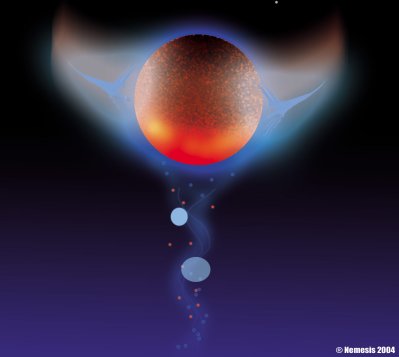
'Nemesis' by David Jackson Jr
I'm finding it strange how astronomers
are becoming more and more interested in the potential for the
involvement of a
Brown Dwarf in the early solar system.
It is in
marked contrast to the population at large whose interest in the
Planet X phenomenon has waned with the timely arrival of 2004.
Perhaps that is exactly why astronomers feel at ease with
speculating about the outer solar system's origins now; the feeding
frenzy of fringe Planet X conjecture has dissipated.
In its wake is
the possibility of a real scientific debate about whether our Sun
became entangled with sizeable objects in the dim and distant past;
interstellar passers-by, brown dwarfs and birth cluster companions.
You see, the birth of our Sun is no longer being discussed in terms
of it lonely entry into a quiet, unremarkable backwater of the
galaxy. It may have had siblings; a veritable litter of starlets of
all shapes and sizes whose early presence may not have adversely
affected the inner planets per se, but sure as hell may have knocked
around the outer bodies orbiting the Sun.
Until recently, not enough was known about these bodies, and the
assumption was that they would be found to meander around our Sun in
a more or less orderly fashion.
But, true to form in Science, the unexpected rears its ugly head and
upsets the proverbial apple cart. In this case, the origin of the
planetary system around the Sun. SOMETHING has been creating
patterns of change out there, creating bizarre orbits, creating
headaches for the boffins.
To solve the riddle of objects like Sedna
the astronomers are having to fall back upon an old mainstay beloved
of previous generations of scientists: creative thought. they are
speculating, and the subject of that speculation is eerily
reminiscent of the kind of ideas knocked about on this website.
New Scientist has published a feature outlining the new thinking. An
'implausible' but nevertheless 'cool' suggestion is that Sedna's
controversial orbit could be the result of the early presence of a
Brown Dwarf interacting with the Sun. Yes, yes, YES!
First of all we
have had a similar possibility raised by the peculiar Gap in the Edgeworth-Kuiper Belt; now we have this same solution described to
potentially explain Sedna's orbit.
Can one detect a pattern
emerging?
Here's an extract from the
New Scientist article, details
and link in the references:
"Sedna's orbit is so extreme researchers say it could not have
formed simply from the gravitational kicks of the giant planets,
which are responsible for the eccentric orbits of the comets and
Pluto.
"If this thing was scattered out by a planet, something else
had to change the orbit, something we don't see," says study
co-author Hal Levison, an astronomer at the Southwest Research
Institute in Boulder, Colorado.
"That's why Sedna and
2000 CR-105
[the next most-distant object] are so cool. They tell us something
was different back when they formed." (21)
A number of solutions are put forward, including a stellar fly-by
and an embedded planet in the Edgeworth-Kuiper Belt at about 75AU.
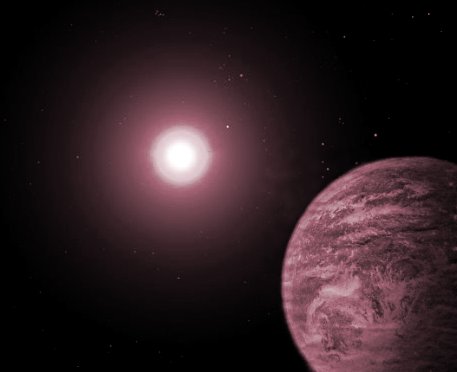
Both of these solutions have problems, the former as described by Quillen
(10), the latter by the evident lack of a candidate object.
To paraphrase Sir Arthur Conan Doyle, when all other solutions fail
one must start to seriously consider the remaining possibilities, no
matter how 'impossible' they may have first appeared.
"But the researchers thought up another improbable scenario that
managed to explain Sedna's orbit remarkably well. Sedna could have
been born around a brown dwarf about 20 times less massive than the
Sun and captured by our Solar System when the brown dwarf
approached.
"What's striking about this idea is how efficient it
is," says Levison, whose calculations suggest about half of the
material orbiting the dwarf would have gone into orbit around the
Sun. "Even if it's wrong it's a cool idea."
"It just seems implausible, but that doesn't mean it's not true,"
agrees Brown.
"The study is scheduled for publication in November 2004 in the
Astronomical Journal." (21)
Sherlock Holmes would be proud, fellas!
To inject just a little
further controversy, maybe the 'brown dwarf' was a fraction of the
size and ALL of the material went into orbit around the Sun,
including the tiniest wee brown dwarf itself? Then you might as well
call this idea the Dark Star Theory!
So I'm looking forward to
November, I don't mind admitting.
The Dark Satellite??
David Pearson has sent me an excellent reference for the recent
controversy surrounding Sedna's 'missing' moon.
The often
controversial astronomical Professor, Chandra Wickramasinghe,
suggests a satellite may be orbiting Sedna, which would then explain
its slowed observed rate of rotation, but that it's so black that it
would be the darkest body yet discovered in the Solar System:
"Writing in the astronomical magazine
The Observatory, Prof Wickramasinghe and his colleagues, who include his daughter Janaki
and Professor Bill Napier, suggest that Sedna's partner may be more
like a huge extinct comet rather than a rocky planetary body.
They
believe the outer crust of the missing object could be made of
sticky organic particles left behind when the ice that traditionally
forms a comet melts away and was captured by Sedna.
The resulting
body would be so black because much of it is empty space.
"With such a "fairy castle" structure, the moon would absorb more
than 99% of all the light that hit it, the team says.
"Why Sedna
spins so slowly is a mystery but slow spin tends to mean that a moon
is slowing it down," said Prof Wickramasinghe yesterday. If it was a
moon like Pluto's moon Charon, or our own, we should be able to see
it. Why don't we see it? The answer I think is that it's blacker
than black and the only object it could be is a comet, which makes
up some of the darkest objects in the solar system."
"Prof Wickramasinghe said moons, or more technically- termed
satellites, tended to be captured objects and while the debate over
the origin of the Earth's Moon continues, the moons of the outer
planets - and there are plenty of them - had certainly been captured
in the past." (22)
It is also quite possible, however, that Sedna's anomalous rate of
rotation proves to be an observational error.
Given that a satellite
would have to be captured, and that Sedna's orbit doesn't even bring
it into the more densely distributed planetary zone, what
probability is there that it could have captured a comet within the
empty confines of the outer Edgeworth-Kuiper Belt?
But then does anything about Sedna make any sense at all?
Sedna's Surface of Sludge
There have been very many observations of Sedna by investigating
astronomers since its discovery.
It will take a long time to reach
its perihelion, many decades in fact, so we are going to learn a lot
more about it as time goes on. Sedna is no fleeting comet, but
performs a slow procession across the heavens.
Here are some new
findings:
It now appears that its rate of rotation is more like about 10
hours, which is more 'normal' for solar system objects. Scott Gaudi,
an astronomer at the Harvard-Smithsonian Center for Astrophysics,
has taken more than 140 images of Sedna with a 6.5-metre telescope.
This has led to this re-assessment of Sedna's rotational period.
"Most things in the solar system rotate with periods of 10 hours or
less, so this is what you’d expect," says Gaudi (23).
The reddish surface colour of Sedna was always likely to be due to
organic material , and this has proven to be the case.
Sedna differs
from Pluto and Charon in that it is covered in a meter thick coating
of hydrocarbon sludge. At least, this is the conclusion drawn by the
astronomer Chad Trujillo at the Gemini Observatory (23).
The
implication of this is that Sedna does not appear to have
experienced many collisions whilst moving through deep space.
The
logic goes as follows:
-
Sedna, like other outer Solar System bodies,
is composed of rock and ice (sorry, Dr
McCanney, but they are...)
-
If a given body is struck by other debris in the Edgeworth-Kuiper
Belt, then its surface is chipped away exposing ice
-
This then shows
a highly reflective property, making the object brighter in the dim,
reflected solar light
Sedna is dark, so it has not been chipped away as much as Pluto and
Charon.
This implies a quieter life in the EKB
(Edgeworth-Kuiper Belt), which also implies a
low population of other objects in this part of the Solar System. It
still doesn't explain its origin, though, but makes astronomers
think that Sedna's fate was decided about 4 billion years ago.
Roughly the same time as the Late, Great Bombardment, in fact. They
think this is due to a passing star.
I suspect the 'passing star'
checked into the party, raised a ruckus, and then stayed for the
duration.
References
1) NASA Schedules News Briefing about Unusual Solar Object
2)
http://news.bbc.co.uk/1/hi/sci/tech/3506329.stm
3) D. Whitehouse "Astronomers Discover new planet" 15th March 2004
http://news.bbc.co.uk/1/hi/sci/tech/3511678.stm
4) Spitzer Press release, 15th March 2004
http://www.spitzer.caltech.edu/Media/releases/ssc2004-05/release.shtml
Image Credits: NASA/JPL-Caltech/R. Hurt (SSC-Caltech)
5) R. Willis (Ed) "World Mythology" p216-7 Simon & Schuster 1993
6) 'Sedna'
http://www.rahoorkhuit.net/goddess/goddess_quest/sedna.html
7) R. R. Britt " Distant Sedna Raises Possibility of Another
Earth-Sized Planet in Our Solar System" 16th March 2004
http://www.space.com/scienceastronomy/sedna_earth_040316.html With
thanks to David Pearson
8) A. Brunini & M. Melita “The Existence of a Planet beyond 50AU and
the Orbital Distribution of the Classical Edgeworth-Kuiper Belt
Objects” Icarus, 160, pp32-43 (2002)
9) Correspondence from Dr Mario Melita, 15th January 2003
10) A. Quillen, D. Trilling & E. Blackman “The Impact of a Close
Stellar Encounter on the Edgeworth-Kuiper Belt”
arXiv:astro-ph/0401372vl, 2004
11) A. Lloyd "Planet X: Past and Present" UFO Magazine, pp32-7,
January 2004
12) Z. Sitchin "The Twelfth Planet" Avon 1976
13) A. Lloyd "Winged Disc: The Dark Star Theory" Available from the
author, 2001
14) J. Davies "Beyond Pluto" pp94-6 Cambridge University Press 2001
15) A. Burrows, D. Sudarsky & J. Lunine "Beyond the T Dwarfs:
Theoretical Spectra, Colours, and Detectability of the Coolest Brown
Dwarfs" Jun 2003 arXiv:astro-ph/0304226v2
16) Bill Arnett
http://www.nineplanets.org/help.html
17) J. Bagby “Evidence for a Tenth Planet or Massive Solar Companion
beyond Uranus” 1982. Many position papers by John P. Bagby were
published in several lesser-known journals, nevertheless standing as
a substantive public record of his cutting-edge work, including
Kronos 1984; Cornell Engineer 1980, v 45, #4, pp32-4; Cycles Journal
1996, and others published as early as 1972! Thanks to John P. Bagby
for the continued updates since Sedna's discovery.
18) Correspondence from Rajasun, 18th March 2004
19) R. Britt "Weird Object Beyond Pluto Gets Stranger" 14th April
2004
http://www.space.com/scienceastronomy/hubble_sedna_040414.html
With thanks to David Pearson
20) 'Unique moon may partner Sedna' New Scientist
http://www.newscientist.com/news/news.jsp?id=ns99996295 21 August
2004
21) Maggie McKee "Stray Star may have jolted Sedna" 27th July 2004
http://www.newscientist.com/news/news.jsp?id=ns99996204 With thanks
to Lee Covino and Brant McLaughlin for their speedy forwarding of
this important article!
22) The Western Mail "University team's theory causes stir" 30th
August 2004
http://icwales.icnetwork.co.uk/0100news/0200wales/tm_objectid=14585326&method=full&siteid=50082&headline=university-team-s-theory-causes-stir-name_page.html
With thanks to David Pearson
23) Maggie McKee "Distant planetoid Sedna gives up more secrets" New
Scientist, 15th April 2005, with thanks to Lee Covino
http://www.newscientist.com/article.ns?id=dn7272
|










